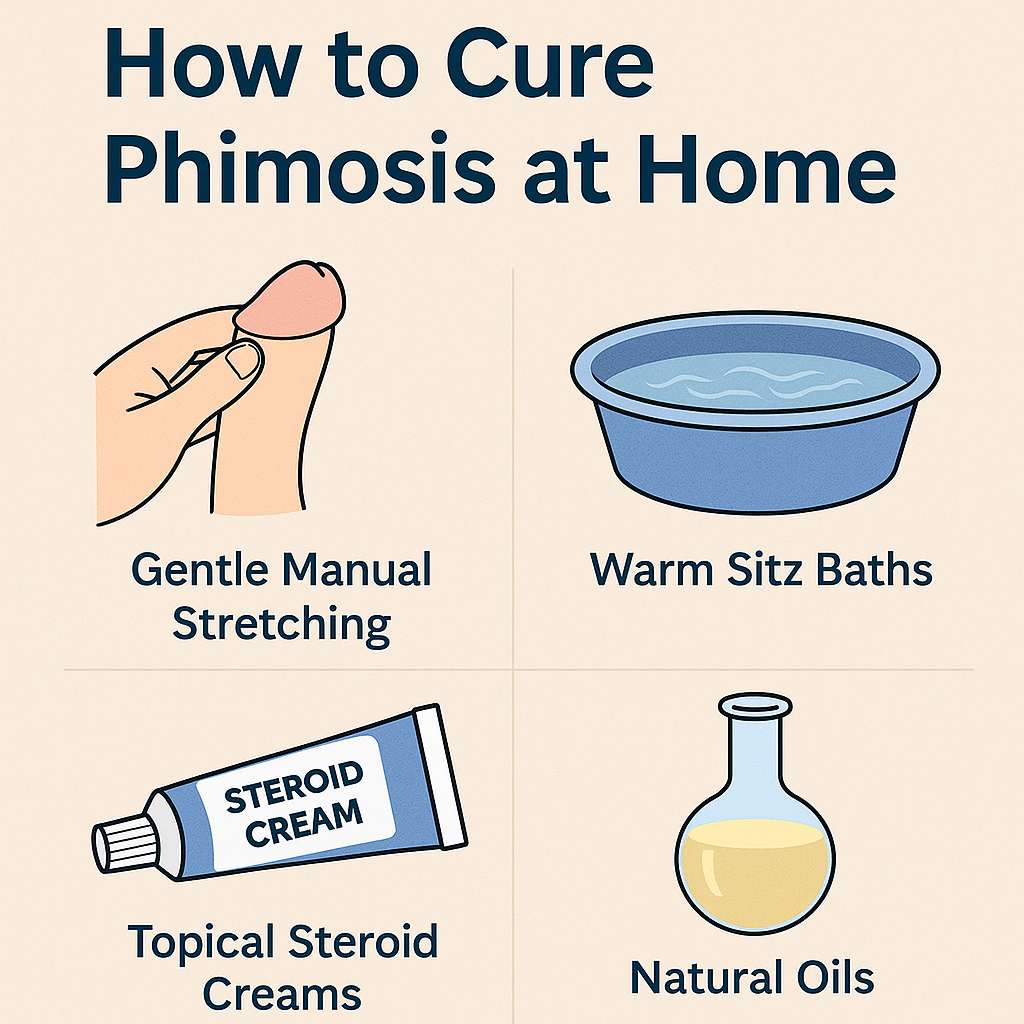Phimosis is a condition where the foreskin of the penis cannot be fully retracted over the glans (head). It is common in young boys and may resolve naturally. However, in some adults or adolescents, treatment may be required.
Note: While home remedies may provide relief in mild cases, medical evaluation is essential before starting any treatment.
What is Phimosis?
- A condition where the foreskin cannot be pulled back over the glans penis
- Common in boys under age 5
- Often resolves naturally by puberty
- Can cause pain, infection, and urinary issues in severe cases
Causes of Phimosis
- Congenital (by birth)
- Poor hygiene
- Repeated infections (Balanitis, Balanoposthitis)
- Chronic inflammation
- Diabetes-related skin issues
- Scarring from forced retraction
Symptoms of Phimosis
- Inability to retract foreskin
- Redness and swelling
- Pain during urination or erection
- White discharge or foul smell
- Ballooning of foreskin while urinating
- Recurrent urinary tract infections (UTIs)
When to Treat Phimosis at Home
- No pain or bleeding
- No signs of infection
- Not interfering with urination
- Mild to moderate tightness
- No scarring or fibrosis of foreskin
Home Remedies for Phimosis
1. Gentle Manual Stretching
- Use clean hands daily
- Pull the foreskin gently backward (not forcefully)
- Repeat for 1–2 minutes twice daily
- Best done during/after a warm bath
2. Warm Sitz Baths
- Fill a tub with warm (not hot) water
- Sit for 10–15 minutes daily
- Helps soften the foreskin and ease retraction
3. Topical Steroid Creams (under medical supervision)
- Apply mild corticosteroids like Betamethasone 0.05%
- Use twice daily for 4–6 weeks
- Helps reduce inflammation and improve elasticity
| Cream Name | Usage | Availability |
|---|---|---|
| Betamethasone 0.05% | Twice daily for 6 wks | Prescription required |
| Hydrocortisone 1% | Twice daily for 4 wks | OTC in some regions |
Always consult a doctor before using any medication.
4. Hygiene Practices
- Gently wash the area daily with warm water
- Avoid harsh soaps or scrubbing
- Dry the area properly to prevent fungal growth
5. Natural Oils for Softening (Optional)
- Use coconut oil or olive oil
- Apply small amount before gentle retraction
- Avoid using irritants or perfumed products
Daily Routine to Follow at Home
| Time | Activity |
|---|---|
| Morning | Warm bath + gentle stretching |
| Noon | Apply prescribed steroid cream |
| Evening | Warm sitz bath + oil application |
| Night | Final stretching before bedtime |
What Not to Do at Home
- Do not forcefully pull the foreskin
- Avoid using harsh chemicals, antiseptics, or scrubs
- Don’t ignore symptoms of pain, swelling, or pus
- Avoid self-medicating with high-strength steroids
- Do not attempt circumcision-like procedures at home
When to See a Doctor
- Pain while urinating or during erection
- No improvement in 4–6 weeks
- Tight ring formation at the tip (Paraphimosis risk)
- Foul-smelling discharge or persistent redness
- Repeated infections or UTIs
- Diabetes or other health conditions
FAQs
1. Is phimosis normal in children?
- Yes, physiological phimosis is common and usually resolves by age 10–13.
2. Can phimosis be cured without surgery?
- Mild cases often improve with stretching and creams. Severe cases may require surgical treatment like circumcision or preputioplasty.
3. How long does stretching take to show results?
- Noticeable improvement may take 4–6 weeks of consistent effort.
4. Can adults use steroid creams for phimosis?
- Yes, under urologist supervision. Do not self-prescribe.
5. Is circumcision the only option for phimosis?
- No, conservative treatments work in many mild to moderate cases. Surgery is reserved for complicated or severe cases.
Disclaimer
- This content is for informational purposes only and does not replace professional medical advice.
- Consult a licensed urologist before beginning any treatment, including home-based care.
- Using steroid creams without guidance can lead to side effects like skin thinning or secondary infections.


Leave a Reply